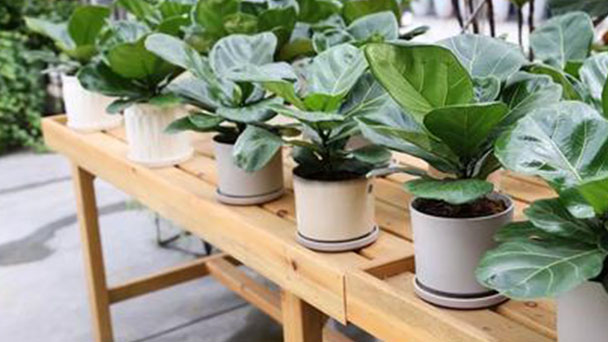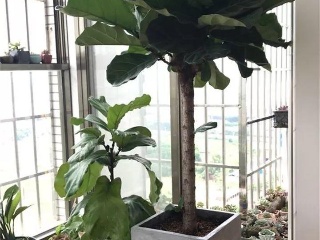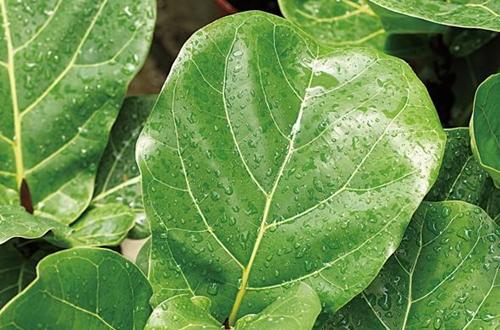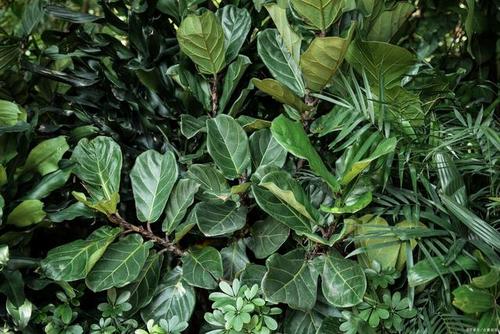How to take care of Fiddle-leaf fig
Written by Maggie
Oct 09 2021

Fiddle-leaf fig is a kind of leaf-watching plant, its leaves are relatively large, thick, and green luster. In recent years it became one of the most popular indoor green plants. How to take care of Fiddle-leaf fig when there are long rust spots or leaves becoming brown for large areas? Let's look together!

Fiddle-leaf fig is one of the best trees for pots
How to take care of Fiddle-leaf fig having long rust spots
In case of long rust spots of Fiddle-leaf fig, appropriate treatment should be timely. If the soil is not appropriate for the timely replacement of soil treatment, the root system to be sterilized before the basin. Watering too much then stop watering, and do not cause waterlogging. If caused by the disease, the plant will be cut off, keep the leaves dry, spray an appropriate amount of Bordeaux liquid. The following are details of how to take care of the Fiddle-leaf fig having long rust spots.
1. Soil replacement treatment
Fiddle-leaf fig is suitable for growth in loose soil with good drainage and breathability. If the soil is too hard, it will easily lead to poor root growth and many spots on the leaves. At this time, soil replacement should be carried out in time.
2. Reduce moisture
Fiddle-leaf fig in ordinary water quantity is determined according to the temperature of the environment, water during the period of spring and summer to keep the soil moist advisable, if the floodwater can lead to water accumulation in the basin, and can also lead to plant grow rusty spot, at this time it should be timely stop watering. The heat can spray into the surrounding water moisture.
3. Reduce fertilizer use
Fiddle-leaf fig is a fattening plant, but do not apply too much or too much fertilizer during the growing period, otherwise, the solution will lead to yellow fertilizer on the plant and spots will appear on the stem and leaves. At this time, stop applying fertilizer, pay attention to ventilation, and put the plant in a cool environment, and then apply fertilizer mainly with thin liquid fertilizer.
4. Disease prevention
When the Fiddle-leaf fig shows long rust spots, the first thing to consider is that it suffers from leaf blight, gray mold, and brown spots, and the plants will slowly wither and die after onset. The diseased plants can be cut off when onset and the flowerpots can be placed in a ventilated environment without spraying water on the leaves, and the corresponding carbapeniline or Bordeaux liquid can be used for spraying prevention and control.
The leaves of Fiddle-leaf fig turn brown due to poor soil drainage and air permeability, insufficient water, lack of light and poor ventilation, etc., which should be adjusted according to plant conditions. If the leaves of the plant are relatively lush, you can remove the residual leaves and place the plant in a suitable environment. If the leaves of plants are sparse, drugs can be used to prevent and treat them.

Fiddle Leaf Fig - one of the best indoor trees
How to take care of Fiddle-leaf fig large area Browning
There are many reasons for the large area Browning of the leaves of Fiddle-leaf fig, insufficient soil nutrition and poor air permeability, insufficient moisture, lack of light and poor ventilation, etc., all lead to the Browning of the leaves of Fiddle-leaf fig. At first, there are long brown spots, then more and more spots, large areas of leaves become brown, accompanied by the phenomenon of leaf litter. The following are details of how to take care of Fiddle-leaf fig large area Browning.
If the leaves of Fiddle-leaf fig are relatively lush, the brown residual leaves can be cleared away, and the Fiddle-leaf fig is moved to a dry and ventilated place, preferably with a good lighting position on the balcony, so as to ensure that the plants can receive enough light. Proper watering should be given during the nursing period. Insufficient water will also lead to discoloration and drying of plant leaves.
If the leaves of Fiddle-leaf fig are sparse and there are many brown residual leaves, it is better to clean up the relatively serious residual leaves first, and put the plants in a cool and ventilated environment with loose and good air permeability. Antimicrobial sprays are needed to improve the condition of plants in order to prevent leaf infections that can lead to more leaf debris.
Cultivation of Fiddle-leaf fig requires humic soil or nutrient soil with good looseness and permeability. It is suitable for growing in an environment of 25 ° c ~ 35 ° C. It likes light and is best exposed to sunlight for about 3 hours a day. Fiddle-leaf fig needs a lot of water, so it is necessary to water it when the nozzle is dry, especially keep the soil moist during spring and summer. In the growing period, it takes about 14 days to apply fertilizer and take measures to prevent diseases and insects.

Latest Updated
- Benefits of Bugleweed - 7 Science-backed Health Benefits
- Bugleweed Dangers & Side Effects - Is It Poisonous?
- How to Plant Evergreen Trees - What You Should Know
- When to Plant Evergreens - Grow Guide for Evergreen Trees
- 12 Wonderful Evergreen Shrubs for Your Garden
- 12 Popular Evergreen Plants with Pictures for Beginners
- When And How To Prune A Lilac Bush Like a Pro
- How to Grow & Care for Lilac Vine (Hardenbergia Violacea)
- Japanese Lilac Tree (Syringa Reticulata) Care & Propagation Guide
- Shumard Oak Pros and Cons - What to Know
Popular Articles
- Winter maintenance of Antirrhinum Majus
- How to Grow Terminalia Mantaly Tree
- How to Grow and Care for Crossostephium Chinense
- How to grow Antirrhinum Majus in spring
- Peristeria Elata (Dove Orchid) Profile: Info & Care Guide
- Underwatered Snake Plant (Sansevieria Trifasciata) - Signs And How To Fix
- How to Care for Brazilian Jasmine Plant (Mandevilla Sanderi)
- How to Grow & Care for Graptopetalum Purple Delight in Summer
- Rosa Chinensis (China Rose): Plant Growing & Care Tips
- How to Care for Baby Sun Rose (Aptenia Cordifolia)